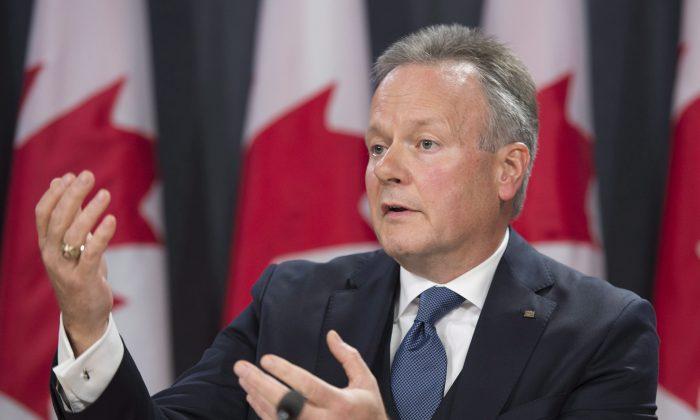OTTAWA—The Bank of Canada downgraded its economic outlook due to systematic weakness in exports and the short-term impact on the housing market stemming from the federal government’s latest measures in its Oct. 19 interest rate decision and Monetary Policy Report (MPR).
In a dovish press release, Canada’s central bank announced it is leaving its overnight rate target at 0.50 percent. This was widely expected, although the Bank’s Governing Council actively discussed cutting rates.
The Bank’s narrative has revolved around a revival of non-energy exports to lead the economic transition, but the first half of 2016 proved to be a major disappointment.
The BoC said the rebound in exports in July and August was not enough to make up for lost ground in the previous five months. The decline in exports is the largely responsible for the fall in 2016 second-quarter gross domestic product (GDP).
“Our latest projections incorporate a permanent shortfall in exports relative to our understanding of fundamentals,” Bank of Canada Governor Stephen Poloz said in the opening remarks at a press conference in Ottawa.
In its MPR, the Bank provided a comprehensive analysis of the problem with exports, noting that Canada’s lack of competitiveness in the U.S. market “appears to be more important than previously assessed.” The loonie not having depreciated as much as, for example, the Mexican peso is one key factor. The peso has fallen over 30 percent against the U.S. dollar since mid-2014, but the loonie has fallen by less than 20 percent.
A rising protectionist sentiment is also bad for exports. This manifests in greater uncertainty around trade agreements and rising non-tariff barriers.
The BoC cut its projection for U.S. business investment, a key driver of Canadian export demand, to 3 percent over 2017–2018 from 4 percent in July’s MPR given the environment of heightened political and economic uncertainty.
“They’ve been claiming the export rebound is just around the corner, but Canada never quite seems to turn that corner,” said Oren Klachkin, Senior Economist at Oxford Economics, in an email to Epoch Times.
While Klachkin doesn’t think a rate cut is likely, he says a boost to competitiveness because of a cheaper loonie after a rate cut wouldn’t do much to boost export growth.
“The issue is frail global demand, particularly in the U.S. where business investment is weak. BoC policy can’t do much to address that.”
New Housing Rules
The Bank also expects the new housing measures—stricter mortgage qualification and portfolio insurance rules, and the closing of loopholes on foreign ownership—to cut real GDP by 0.3 percent at the end of 2018.
Senior Deputy Governor Carolyn Wilkins said the measures don’t change the solid underlying fundamentals of the housing market, but they do improve the quality of borrower.
For managing the housing market, Wilkins reiterated, “Macroprudential tools are better than monetary policy. They’re targeting an actual issue.”
Requiring homebuyers to qualify at a higher rate for fixed-rate mortgages with terms of five years or longer is expected to cause the biggest hit to housing resale activity, but it’s the price to pay in order to bring more stability to the housing market in the longer run.
Poloz said the measures “buy some insurance.”
“By paying a bit of price there you avoid ultimately something that could be much worse for the economy,” he added.
But Klachkin points out the measures will impact all of Canada even though they target Vancouver and Toronto. “The measures may curb activity in places where it doesn’t really need to be contained,” he said.
Fleeting Positive Signs
The BoC now expects the economy to grow by 1.1 percent in 2016, 2.0 percent in 2017, and 2.1 percent in 2018. These projections are lower than July’s figures by 0.2 percent in 2016 and 2017, and 0.1 percent in 2018.
The Bank expects the economy to return to full capacity around mid-2018, which it notes is “materially later” than it had anticipated in July. Though the Bank says inflation is tracking slightly below expectations because of temporary factors, it didn’t cut rates. It expects inflation to reach the 2 percent target in early 2017.
Despite more doom and gloom the BoC tried to provide a ray of optimism. Solid growth in the services sector, a bottoming-out of business investment in the energy sector, and government spending are factors that should lead to better growth in 2017.
“Non-resource activity is growing solidly, particularly in the services sector,” said the Bank of Canada in its press release. Service exports as a share of total exports now exceeds energy exports.
According to the BoC, the services sector accounts for about 70 percent of the economy and four out of every five jobs. Coincident with the slump in commodity prices, the services sector has expanded at a steady pace and has created nearly 250,000 jobs, while the goods sector has seen 70,000 job losses.
The Bank’s Business Outlook Survey recently showed that for the first time since early 2015, firms in the energy sector are getting accustomed to the lower currency and oil prices and thus view it as a positive for business prospects over the next year.
The BoC also believes the U.S. economy is strengthening, underpinned by strong job growth and consumer confidence.
But given the worsening outlook and exposition of structural problems plaguing exports, the positives are fleeting.
“This is a Bank that has precisely zero appetite for rate hikes, and is keeping a flame alive for the possibility of rate cuts, should the need arise,” said BMO Chief Economist Doug Porter in a note.
Follow Rahul on Twitter @RV_ETBiz






Friends Read Free